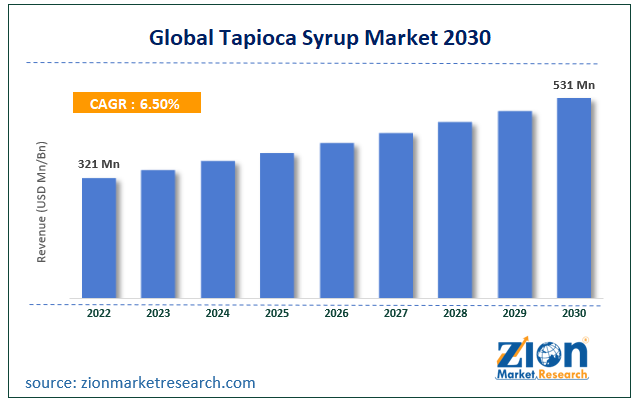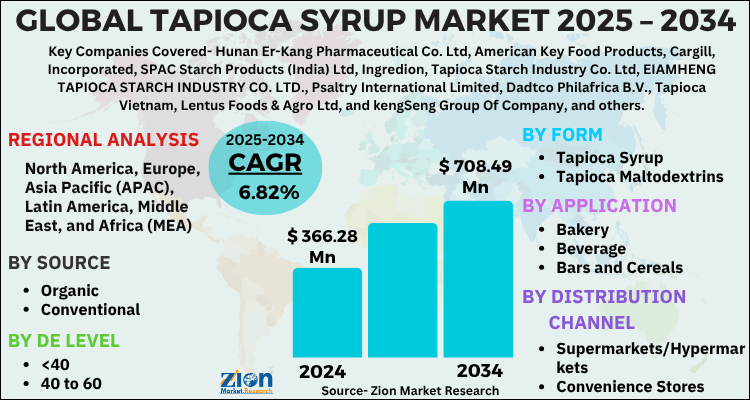Tapioca Syrup Market Size, Share Report, Analysis, Trends, Growth, 2034

Tapioca Syrup Market By Source (Organic, Conventional), By DE Level (<40, 40 to 60, >60, High Maltose), By Form (Tapioca Syrup, Tapioca Maltodextrins, Tapioca Syrup Solids), By Application (Bakery, Beverage, Bars and Cereals, Confectionery and Snacks, Dressings and Sauces, Dairy, Pharmaceuticals, Others), By Distribution Channel (Supermarkets/Hypermarkets, Convenience Stores, Online, Others), and By Region: Global and Regional Industry Overview, Market Intelligence, Comprehensive Analysis, Historical Data, and Forecasts 2025 - 2034
| Market Size in 2024 | Market Forecast in 2034 | CAGR (in %) | Base Year |
|---|---|---|---|
| USD 366.28 Million | USD 708.49 Million | 6.82% | 2024 |
Tapioca Syrup Market: Industry Perspective
The global tapioca syrup market size was worth around USD 366.28 Million in 2024 and is predicted to grow to around USD 708.49 Million by 2034 with a compound annual growth rate (CAGR) of roughly 6.82% between 2025 and 2034. The report analyzes the global tapioca syrup market's drivers, restraints/challenges, and the effect they have on the demands during the projection period. In addition, the report explores emerging opportunities in the tapioca syrup industry.
The report analyzes the global tapioca syrup industry drivers, restraints/challenges, and the effect they have on the demands during the projection period. In addition, the report explores emerging opportunities in the tapioca syrup market.
Tapioca Syrup Market: Overview
Tapioca syrup is a sweetener derived from tapioca starch, which is extracted from the cassava root. It is a natural alternative to traditional sweeteners such as cane sugar or corn syrup. Tapioca syrup is often used as an ingredient in various food products, including baked goods, beverages, and confectionery. The process of producing tapioca syrup involves breaking down the tapioca starch into smaller components through enzymatic hydrolysis. This process converts the starch into simpler sugars, primarily glucose. The resulting syrup has a thick and viscous consistency, similar to corn syrup. Tapioca syrup is known for its neutral flavor, making it a versatile sweetener that does not overpower the taste of other ingredients in a recipe. It also has a high level of sweetness, comparable to traditional sweeteners. One of the advantages of tapioca syrup is that it is considered to have a lower glycemic index compared to some other sweeteners. This means it is absorbed more slowly by the body, resulting in a slower rise in blood sugar levels. As a result, tapioca syrup may be a preferred sweetener for individuals seeking to manage their blood sugar levels. The demand for alternative sweeteners has been on the rise due to increasing consumer preferences for natural and healthier ingredients. Tapioca syrup has emerged as a potential substitute for corn syrup and other refined sugars in many applications. Its neutral flavor and versatility have made it a popular choice for food manufacturers looking to create products with cleaner labels and reduced sugar content.
Key Insights
- As per the analysis shared by our research analyst, the global tapioca syrup market is estimated to grow annually at a CAGR of around 6.82% over the forecast period (2025-2034).
- Regarding revenue, the global tapioca syrup market size was valued at around USD 366.28 Million in 2024 and is projected to reach USD 708.49 Million by 2034.
- The tapioca syrup market is projected to grow at a significant rate due to increasing consumer demand for natural, clean-label, and healthier sweeteners, rising popularity of plant-based and vegan food products, and growing versatility of tapioca syrup in various food and beverage applications like bakery, confectionery, and functional drinks.
- Based on Source, the Organic segment is expected to lead the global market.
- On the basis of DE Level, the <40 segment is growing at a high rate and will continue to dominate the global market.
- Based on the Form, the Tapioca Syrup segment is projected to swipe the largest market share.
- By Application, the Bakery segment is expected to dominate the global market.
- In terms of Distribution Channel, the Supermarkets/Hypermarkets segment is anticipated to command the largest market share.
- Based on region, Asia-Pacific is predicted to dominate the global market during the forecast period.
Tapioca Syrup Market: Growth Drivers
Growing demand for organic products and rising health consciousness drive the market growth
Consumers are becoming more conscious of the ingredients used in their food and beverages. Tapioca syrup, being a natural sweetener derived from tapioca starch, appeals to consumers seeking clean-label alternatives to artificial sweeteners or refined sugars. In addition, with rising concerns about the health risks associated with high sugar consumption, there is a growing demand for lower-glycemic sweeteners. Tapioca syrup's lower glycemic index compared to some other sweeteners makes it an attractive choice for health-conscious consumers. Thus, growing demand for organic or natural products and rising health consciousness among consumers is one of the significant factors that propel the growth of the global tapioca syrup market during the forecast period.
Tapioca Syrup Market: Restraints
Availability of substitutes and limited awareness act as major restraints for the market expansion
Tapioca syrup competes with other natural sweeteners like agave syrup, maple syrup, and honey. These alternatives may offer similar attributes and appeal to specific consumer preferences or market segments. The availability and accessibility of these alternatives can impact the demand for tapioca syrup. Besides, while tapioca syrup has gained popularity, its awareness and familiarity among consumers may still be limited compared to more widely used sweeteners. Consumer education and marketing efforts are necessary to increase awareness and promote the benefits of tapioca syrup, which can be a barrier to its wider adoption. Therefore, the availability of substitutes and lack of awareness is expected to hamper the growth of the tapioca syrup industry during the forecast period.
Tapioca Syrup Market: Opportunities
The growing plant-based and vegan market offers a significant opportunity
The rising trend of people living vegetarian or vegan lifestyles. This is especially true in high-income countries where veganism and vegetarianism are becoming increasingly popular, such as the United States, Canada, and the United Kingdom. Additionally, customers who are not exactly vegan but are seeking better and more sustainable food alternatives are increasing their demand for vegan products. It can be used in plant-based food and beverage products as a natural alternative to animal-based sweeteners, appealing to consumers following plant-based or vegan lifestyles. Tapioca syrups can be used in plant-based food and beverage products as a natural alternative to animal-based sweeteners, appealing to consumers following plant-based or vegan lifestyles. Thus, the growing plant-based and vegan market is expected to provide a lucrative opportunity for tapioca syrup industry growth during the forecast period.
Tapioca Syrup Market: Challenges
Regulatory and labeling requirements pose a major challenge
Compliance with regulatory standards and labeling requirements can pose challenges for the tapioca syrup market. Different countries and regions may have specific regulations regarding sweeteners, including labeling requirements and maximum usage levels. Meeting these requirements can involve additional costs and complexities for manufacturers. Thus, acting as a major challenge to tapioca syrup market growth.
Tapioca Syrup Market: Segmentation
The global tapioca syrup industry is segmented based on source, DE level, form, application, distribution channel, and region.
Based on the source, the global market is bifurcated into organic and conventional. The organic segment is expected to grow at a significant rate over the forecast period. Consumers are showing a growing preference for organic food and beverages due to concerns about pesticides, genetically modified organisms (GMOs), and the overall environmental impact of conventional farming practices. Organic tapioca syrup caters to this demand by being derived from cassava plants cultivated without synthetic fertilizers, pesticides, or GMOs. Thus, the growing health consciousness among consumers or inclination towards organic food is expected to drive the segment growth over the forecast period.
Based on the DE level, the global tapioca syrup industry is divided into <40, 40 to 60, >60, and high maltose.
Based on the form, the global tapioca syrup industry is bifurcated into tapioca syrup, tapioca maltodextrins, and tapioca syrup solids. The tapioca syrup segment is expected to dominate the market during the forecast period. The growth in the segment is attributed to the wide range of applications in the food & beverages industry. Tapioca syrup finds applications in various food products such as bakery goods, cereals, snacks, desserts, sauces, and dressings. In addition to this, it is used in beverages like flavored drinks, energy drinks, smoothies, and cocktails. Thereby, driving the segment growth.
Based on the application, the market is segmented into bakery, beverages, bars and cereals, confectionery and snacks, dressings and sauces, dairy, pharmaceuticals, and others.
Based on the distribution channel, the market is segmented into supermarkets/hypermarkets, convenience stores, online, and others.
Recent Developments:
- In May 2023, three new syrups have been released by Ciranda, a North American supplier of certified organic, non-GMO, and fair-trade food ingredients, to assist CPG businesses and product developers in developing new goods that satisfy customer desire for less sugar in their diets. The new syrups include Tapioca Syrup RS18, which is accessible without genetically modified organisms (GMOs); Agave Syrup AL40; and Agave Syrup IN10; all of which are organic and free of GMOs. They can be blended in products like pastries, bars, ice cream, cereals, drinks, and candies, among others, or used as single-syrup substitutes for conventional syrups.
- In October 2022, Cargill increased the processing capabilities of its sweetener facility in Cikande, Indonesia, more than doubling the company's ability to produce organic, non-GMO tapioca syrup in response to persistent market demand for ingredients that are label-friendly.
Tapioca Syrup Market: Report Scope
| Report Attributes | Report Details |
|---|---|
| Report Name | Tapioca Syrup Market |
| Market Size in 2024 | USD 366.28 Million |
| Market Forecast in 2034 | USD 708.49 Million |
| Growth Rate | CAGR of 6.82% |
| Number of Pages | 227 |
| Key Companies Covered | Hunan Er-Kang Pharmaceutical Co. Ltd, American Key Food Products, Cargill, Incorporated, SPAC Starch Products (India) Ltd, Ingredion, Tapioca Starch Industry Co. Ltd, EIAMHENG TAPIOCA STARCH INDUSTRY CO. LTD., Psaltry International Limited, Dadtco Philafrica B.V., Tapioca Vietnam, Lentus Foods & Agro Ltd, and kengSeng Group Of Company, and others. |
| Segments Covered | By Source, By DE Level, By Form, By Application, By Distribution Channel, and By Region |
| Regions Covered | North America, Europe, Asia Pacific (APAC), Latin America, The Middle East and Africa (MEA) |
| Base Year | 2024 |
| Historical Year | 2020 to 2024 |
| Forecast Year | 2025 to 2034 |
| Customization Scope | Avail customized purchase options to meet your exact research needs. Request For Customization |
Tapioca Syrup Market: Regional Analysis
The Asia Pacific is expected to dominate the market during the forecast period
The Asia Pacific is expected to dominate the global tapioca syrup market over the forecast period. Countries like Thailand, Vietnam, Indonesia, and China are major producers and consumers of tapioca syrup in the region. The market size is expected to witness significant growth, driven by factors such as population growth, changing dietary habits, and increasing consumer awareness of healthier sweetener alternatives.
North America is expected to capture a substantial market share over the forecast period. This significant percentage is a result of the region's high rates of production and consumption as well as syrup exports to other countries. The region's consumers choose a wide range of breakfast alternatives, which contributes to the strong demand for flavored syrups. Syrups go particularly well with breakfast foods and hot and cold beverages among consumers in the area. In addition, the region's demand for syrups has increased due to the rising trend of utilizing syrups as toppings on easily available snack foods. Due to rising concerns for the environment, health, and consumer well-being, organic fruit has been gaining favor with Americans. As a result, the United States and Canada are at the forefront of innovation in organic syrups and natural sweeteners for the North American market.
Tapioca Syrup Market: Competitive Analysis
The report provides a company market share analysis to give a broader overview of the key market players. In addition, the report also covers key strategic developments of the market, including acquisitions & mergers, new product launches, agreements, partnerships, collaborations & joint ventures, research & development, and regional expansion of major participants involved in the tapioca syrup market on a global and regional basis.
The global tapioca syrup market is dominated by players like:
- Hunan Er-Kang Pharmaceutical Co. Ltd
- American Key Food Products
- Cargill
- Incorporated
- SPAC Starch Products (India) Ltd
- Ingredion
- Tapioca Starch Industry Co. Ltd
- EIAMHENG TAPIOCA STARCH INDUSTRY CO. LTD.
- Psaltry International Limited
- Dadtco Philafrica B.V.
- Tapioca Vietnam
- Lentus Foods & Agro Ltd
- kengSeng Group Of Company
- Others.
The global tapioca syrup market is segmented as follows:
By Source
- Organic
- Conventional
By DE Level
- <40
- 40 to 60
- >60
- High Maltose
By Form
- Tapioca Syrup
- Tapioca Maltodextrins
- Tapioca Syrup Solids
By Application
- Bakery
- Beverage
- Bars and Cereals
- Confectionery and Snacks
- Dressings and Sauces
- Dairy
- Pharmaceuticals
- Others
By Distribution Channel
- Supermarkets/Hypermarkets
- Convenience Stores
- Online
- Others
By Region
- North America
- The U.S.
- Canada
- Europe
- France
- The UK
- Spain
- Germany
- Italy
- Rest of Europe
- Asia Pacific
- China
- Japan
- India
- South Korea
- Southeast Asia
- Rest of Asia Pacific
- Latin America
- Brazil
- Mexico
- Rest of Latin America
- Middle East & Africa
- GCC
- South Africa
- Rest of Middle East & Africa
Table Of Content
Methodology
FrequentlyAsked Questions
Tapioca syrup is a sweetener derived from tapioca starch, which is extracted from the cassava root. It is a natural alternative to traditional sweeteners such as cane sugar or corn syrup. Tapioca syrup is often used as an ingredient in various food products, including baked goods, beverages, and confectionery.
The global tapioca syrup market is expected to grow due to rising demand for natural sweeteners, increasing gluten-free and clean-label food trends, and growing applications in beverages, confectionery, and bakery products.
According to a study, the global tapioca syrup market size was worth around USD 366.28 Million in 2024 and is expected to reach USD 708.49 Million by 2034.
The global tapioca syrup market is expected to grow at a CAGR of 6.82% during the forecast period.
The global tapioca syrup market growth is expected to be driven by the Asia Pacific. It is currently the world’s highest revenue-generating market owing to the growing trends for organic products.
The global tapioca syrup market is dominated by players like Hunan Er-Kang Pharmaceutical Co., Ltd, American Key Food Products, Cargill, Incorporated, SPAC Starch Products (India) Ltd, Ingredion, Tapioca Starch Industry Co., Ltd, EIAMHENG TAPIOCA STARCH INDUSTRY CO., LTD., Psaltry International Limited, Dadtco Philafrica B.V., Tapioca Vietnam, Lentus Foods & Agro Ltd, and kengSeng Group Of Company among others.
The report explores crucial aspects of the tapioca syrup market, including a detailed discussion of existing growth factors and restraints, while also examining future growth opportunities and challenges that impact the market.
RelatedNews
HappyClients
Zion Market Research
Tel: +1 (302) 444-0166
USA/Canada Toll Free No.+1 (855) 465-4651
3rd Floor,
Mrunal Paradise, Opp Maharaja Hotel,
Pimple Gurav, Pune 411061,
Maharashtra, India
Phone No +91 7768 006 007, +91 7768 006 008
US OFFICE NO +1 (302) 444-0166
US/CAN TOLL FREE +1 (855) 465-4651
Email: sales@zionmarketresearch.com
We have secured system to process your transaction.
Our support available to help you 24 hours a day, five days a week.
Monday - Friday: 9AM - 6PM
Saturday - Sunday: Closed






